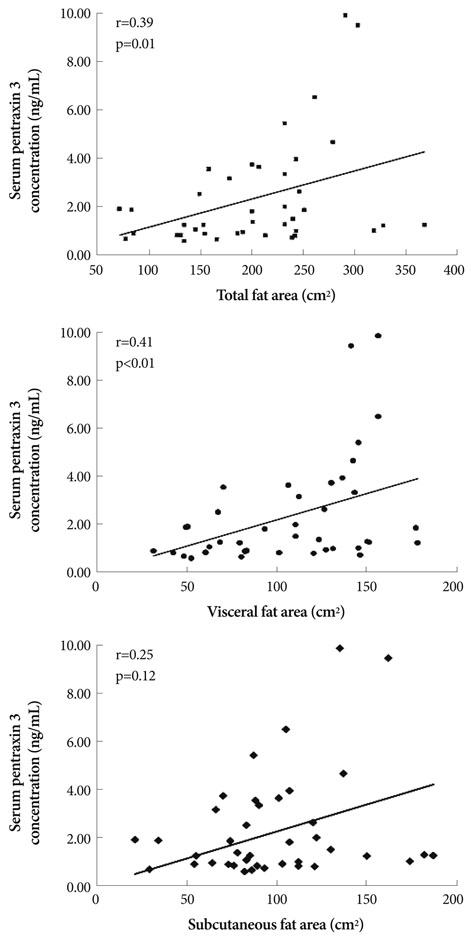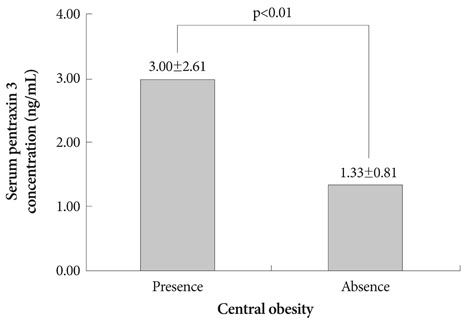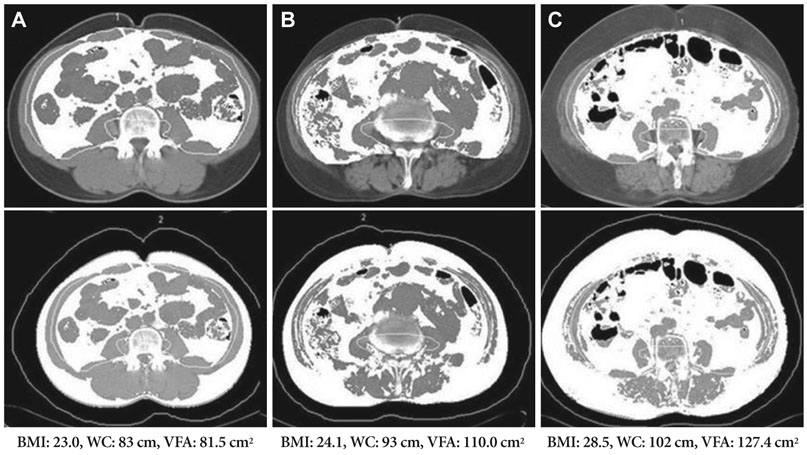Korean Circ J.
2010 Jul;40(7):308-313. 10.4070/kcj.2010.40.7.308.
The Relationship Between Serum Pentraxin 3 and Central Obesity in ST-Segment Elevation Myocardial Infarction Patients
- Affiliations
-
- 1Division of Cardiology, Department of Internal Medicine, College of Medicine, The Catholic University of Korea, Seoul, Korea. jhkmht@catholic.ac.kr
- KMID: 2225173
- DOI: http://doi.org/10.4070/kcj.2010.40.7.308
Abstract
- BACKGROUND AND OBJECTIVES
As shown in previous studies, pentraxin 3 (PTX3) can be a useful inflammatory marker for metabolic syndrome and central obesity. Serum PTX3 levels are also an independent factor associated with visceral fat area. The aim of this study was to assess the role of PTX3 as an inflammatory maker in patients with central obesity undergoing primary percutaneous coronary intervention (PCI) following an ST-segment elevation myocardial infarction (STEMI).
SUBJECTS AND METHODS
From December 2007 to June 2008, 40 subjects (mean age: 61+/-11 years, M : F=34 : 6) with STEMI who underwent primary PCI were enrolled. We determined waist circumference, waist/hip ratio, body mass index (BMI), and visceral and total fat area via fat computed tomography (FAT-CT), and compared them with serum PTX3 concentrations.
RESULTS
The serum PTX3 concentration was closely related to FAT-CT-estimated visceral fat area (r=0.41, p<0.01) and total fat area (r=0.38, p=0.01), respectively. The serum PTX3 concentration was not related to waist circumference (r=0.27, p=0.20), waist circumference/hip ratio (r=0.25, p=0.16), BMI (r=0.04, p=0.80) and lipid profiles, respectively. Among the parameters determining metabolic syndrome, an increasing visceral fat area had the strongest association with PTX3 concentrations.
CONCLUSION
In patients with STEMI, PTX3 is associated with central obesity and it is significantly and independently correlated with visceral fat area. FAT-CT-estimated visceral fat area is the most reliable factor associated with serum PTX3 levels in patients with STEMI and central obesity.
Keyword
MeSH Terms
Figure
Reference
-
1. Lusis AJ. Atherosclerosis. Nature. 2000. 407:233–241.2. Noh HJ, Kwon NH, Joo SB. Severity of coronary atherosclerosis: influence of metabolic syndrome risk factor clustering and hs-CRP. Korean Circ J. 2006. 36:802–808.3. Rattazi M, Faggin E, Bertipaglia B, Pauletto P. Innate immunity and atherogenesis. Lupus. 2005. 14:747–751.4. Hansson GK, Robertson AL, Soderberg-Naucler C. Inflammation and atherosclerosis. Annu Rev Pathol. 2006. 1:297–329.5. Koo BK, Choi DH, Ryu SK, et al. Role of inflammation on coronary artery disease in Koreans. Korean Circ J. 2002. 32:988–995.6. Kim TI, Chae SC, Yang DH, Shin SC, et al. Short-term prognostic value of CRP in the patients with acute coronary syndrome. Korean Circ J. 2000. 30:1387–1394.7. Mantovani A, Garlanda C, Bottazzi B. Pentraxin 3, a non-redundant soluble pattern recognition receptor involved in innate immunity. Vaccine. 2003. 21:Suppl 2. S43–S47.8. Mantovani A, Garlanda C, Bottazzi B, et al. The long pentraxin PTX3 in vascular pathology. Vascul Pharmacol. 2006. 45:326–330.9. Napoleone E, Di Santo A, Bastone A, et al. Long pentraxin PTX3 upregulates tissue factor expression in human endothelial cells: a novel link between vascular inflammation and clotting activation. Arterioscler Thromb Vasc Biol. 2002. 22:782–787.10. Peri G, Introna M, Corradi D, et al. PTX3, A prototypical long pentraxin, is an early indicator of acute myocardial infarction in humans. Circulation. 2000. 102:636–641.11. Suzuki S, Takeishi Y, Niizeki T, et al. Pentraxin 3, a new marker for vascular inflammation, predicts adverse clinical outcomes in patients with heart failure. Am Heart J. 2008. 155:75–81.12. Moon DK, Lee DH, Youn HJ, et al. Pentraxin 3 as an inflammatory marker in subjects with metabolic syndrome. Korean J Med. 2007. 451S. Abstract.13. Alberti L, Gilardini L, Zulian A, et al. Expression of long pentraxin PTX3 in human adipose tissue and its relation with cardiovascular risk factors. Atherosclerosis. 2009. 202:455–460.14. Kim JA, Choi CJ, Yum KS. Cut-off values of visceral fat area and waist circumference: diagnostic criteria for abdominal obesity in a Korean population. J Korean Med Sci. 2006. 21:1048–1053.15. Zenetti M, Bosutti A, Ferreira C, et al. Circulating pentraxin 3 levels are higher in metabolic syndrome with subclinical atherosclerosis: evidence for association with atherogenic lipid profile. Clin Exp Med. 2009. 9:243–248.16. Latini R, Maggioni AP, Peri G, et al. Prognostic significance of the long pentraxin PTX3 in acute myocardial infarction. Circulation. 2004. 110:2349–2354.17. Introna M, Alles VV, Castellano M, et al. Cloning of mouse PTX3, a new marker of the pentraxin gene family expressed at extrahepatic sites. Blood. 1996. 87:1862–1872.18. Presta M, Camozzi M, Salvatori G, Rusnati M. Role of the soluble pattern recognition receptor PTX3 in vascular biology. J Cell Mol Med. 2007. 11:723–738.19. Tilg H, Moschen AR. Adipocytokines: mediators linking adipose tissue, inflammation and immunity. Nat Rev Immunol. 2006. 6:772–783.20. Takeno M, Yasuda S, Otsuka Y, et al. Impact of metabolic syndrome on the long-term survival of patients with acute myocardial infarction-potential association with C-reactive protein. Circ J. 2008. 72:415–419.21. Clavijo LC, Pinto TL, Kuchulakanti PK, et al. Metabolic syndrome in patients with acute myocardial infarction is associated with increased infarct size and in-hospital complications. Cardiovasc Rrevasc Med. 2006. 7:7–11.22. Yusuf S, Hawken S, Ounpuu S, et al. Obesity and the risk of myocardial infarction in 27000 participants from 52 countries: a case-control study. Lancet. 2005. 366:1640–1649.23. Kip KE, Marroquin OC, Kelley DE, et al. Clinical importance of obesity versus the metabolic syndrome in cardiovascular risk in women. Circulation. 2004. 109:706–713.
- Full Text Links
- Actions
-
Cited
- CITED
-
- Close
- Share
- Similar articles
-
- A Case of ST-Segment Elevation in a Patient with Subarachnoid Hemorrhage
- ST segment
- Acute Myocardial Infarction by Right Coronary Artery Occlusion Presenting as Precordial ST Elevation on Electrocardiography
- Differences in Clinical Outcomes Between Patients With ST-Elevation Versus Non-ST-Elevation Acute Myocardial Infarction in Korea
- Erratum: Etiologies and Predictors of False-Positive Diagnosis of ST-Segment Elevation Myocardial Infarction




